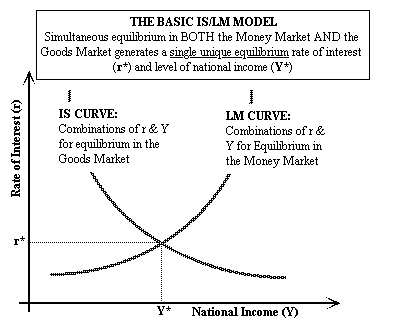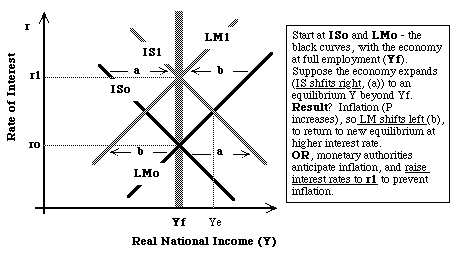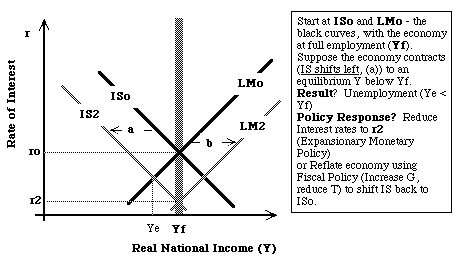THE MACROECONOMY - part 2
Contents:
- IS/LM picture of Real (Goods) markes and Money
markets interaction
- International Trade and the Forex Market
- MacroEconomic Management
1. Macroeconomics of
Money with the CFoI( IS/LM)
Management of the Macroeconomy depends on achieving an appropriate
balance
between the markets for goods and services (as represented by the CFoI)
and the money markets (as above - in previous notes).
It therefore depends on achieving an appropriate balance between the
two major levers of macroeconomic management: Fiscal Policy and
Monetary
Policy.
The Key variables in this balance are the level of national income
(Y) and the rate of interest (r) - charted on the IS/LM diagram:
 The IS curve
refers to the equilibrium levels of National Income in the markets
for
goods and services (CFoI). Here, higher rates of interest are
associated with lower levels of spending (higher savings, lower
investment,
lower levels of consumption) - so the IS curve slopes downwards. Note
the direction of causation: setting the interest rate determines
savings (withdrawals) and investment (injections), which then
determines
the equilibrium level of national income.
The IS curve
refers to the equilibrium levels of National Income in the markets
for
goods and services (CFoI). Here, higher rates of interest are
associated with lower levels of spending (higher savings, lower
investment,
lower levels of consumption) - so the IS curve slopes downwards. Note
the direction of causation: setting the interest rate determines
savings (withdrawals) and investment (injections), which then
determines
the equilibrium level of national income.
The LM curve refers to the equilibrium in the Money Markets
-
given
a fixed money supply. Here, higher levels of national income lead
to
greater demand for money (for transactions), and hence higher rates of
interest (given a fixed money supply)- so the LM curve slopes upwards.
Note the direction of causation (opposite from IS curve) -
incomes
drive the demand for money, which then sets the interest rate if the
supply
of money is fixed (or sets the supply of money if the interest rate is
fixed)
Fiscal Policy affects the IS curve - expansionary
(increase
G, reduce T) shifts IS right, and vice versa.
Monetary Policy affects the LM curve - expansionary
(increasing
Ms, reducing interest rates) shifts LM right, and vice versa.
The relative effectiveness of Monetary and Fiscal Policies in
influencing
Y (and thus employment) depends, therefore, on the slopes of the IS and
LM curves (which are summaries of very complex behaviours in both the
real goods and the money markets)
The steeper the LM curve, the greater the "crowding out" effect
of government spending - G increases increase interest rates which
reduce
(crowd out) private spending.
Inflation effects - If equilibrium Y* is greater than the full
capacity of the economy - there will be pressure on prices - leading to
inflation. Inflation reduces the value of the fixed Money
Supply,
shifting LM left, raising interest rates and reducing Y* back
towards
its full capacity level.
BoE Monetary Policy Committee raising interest rates to limit inflation
is the practical
counterpart of this effect - by rasing interest rates, the MPC
effectively
holds the Money Supply constant in the face of increasing demand.
Back to Contents.
2. Macroeconomics
of
International Trade
What, if anything, balances Imports with Exports in the
CFoI?
The Foreign Exchange (Forex) market - where people and
businesses
trade one currency for another.
- Demand for sterling (= supply of forex) depends on exports
of goods and services, and on inward flows of investment funds from
abroad
(capital inflows)
- Supply of sterling (= demand for forex) depends on imports
of goods and services, and on outward flows of investment funds from
the
UK to foreign countries (capital outflows)
- Balance of Payments (BoP) records all these transactions:
- Current Account (Exports vs. Imports)
- balance of visible trade
- balance of invisible trade (services, tourism travel etc.)
- Capital Account (flows of investment (financial) funds
into and
out of the country
- Official Financing - change in the BoE forex reserves.
The 1996 UK situation:
 Demand
: Ceteris paribus, exports and capital inflows will be
greater
the lower the exchange rate - demand curve slopes downwards.
Demand
: Ceteris paribus, exports and capital inflows will be
greater
the lower the exchange rate - demand curve slopes downwards.
Supply : ceteris paribus, will be greater the higher
is the exchange rate - the supply curve slopes upwards.
Equilibrium exchange rate balances exports plus capital inflows
with imports plus capital outflows.
Exchange rate managed by BoE control of Forex reserves, and
also through borrowing (repaying) loans from foreign banks.
Dforex and Sforex are also affected by Incomes (Y) and Interest rates
- Increasing Income shifts Sf right (increasing demand for imports)
-> e.r.
depreciation or BoP deficit
- Increasing Interest rates shift Sf left (discouraging capital
outflows),
and Df right (encouraging capital inflows -> e.r. appreciation or
BoP surplus
Monetary Policy more powerful under floating exchange rates than
fixed:
Expansionary monetary policy:
- Increases Y
- Reduces r
- depreciates e.r -> more expensive imports, more competitive
exports ->
further expansionary effect.
- more likely to generate inflation
Under fixed exchange rates, domestic expansion tends to increase
imports faster than exports, opening up a trade deficit. If this
deficit is not counter-balanced by a tight monetary policy (higher
interest rates), then the BoP deficit tends to get worse - and can only
be financed by running down forex reserves (or increased borrowing from
abroad by the Central Bank). The cure is then contraction of the
domestic economy, tight fiscal and monetary policy, or devluation -
which will tend to lead to inflation.
Purchasing Power Parity: this theory is derived from the fact
that, in the long run, we would expect the exchange rate to adjust to
actual trade flows, rather than to capital flows, since the latter
should ultimately reflect the international competitiveness of the
economy. If trade were all one way (all imports, for instance,
and no exports) then the exchange rate would depreciate, since
more people would be trying to sell the currency than trying to buy
it. On the other hand, if trade were all exports and no imports,
then the exchange rate would be expected to appreciate. When in
balance, imports will equal exports, and the exchange rate will be
stable. What this means is that exchange rates will tend to
adjust (in the long run) so that the prices of tradable goods are the
same in all countries in the trading world - so there is no incentive
to buy in one place and sell in another. So long as there is no other
intervention (taxes or subsidies etc.) in the domestic markets, then
prices will be the same valued at the so-called purchasing power
parity rates. The Economist regularly approximates these rates by
calculating the exchange rates which would have to hold if the price of
a Big Mac hamburger were to be same the world over (assuming that Big
Mac hamburgers are essentially tradable). See
here for the latest version of this calculation, and the
explanation.
NOTE: the capital account is typically much larger than the
current (trade) account. Capital inflows and outflows dominate export
and import flows, so the exchange rate is typically very sensitive to
capital movements, especially short term capital flows (unless these
are controlled). This can cause serious short term problems:
* Any currency which is viewed by the market as
being vulnerable is subject to considerable short term capital
outflows, which makes the currency even more vulnerable and liable to
devaluation of fixed rate or depreciation of a floating rate.
Speculative bubbles (either bull or bear) are frequent in Forex markets
for currencies which governments seek to control, especially but not
only for the lesser currencies (can even affect the major currencies -
euro, $, yen, £)
* rapid growth from Foreign Direct Investment (FDI)
- direct, because it refers to actual purchases of goods and services
and physical investment) tends to lead to currency appreciation as a
result of the capital inflows, as does an increase in the price of raw
materials and fuels, for net exporters of these goods (sometimes called
the Dutch disease, after the experience of the Netherlands when North
Sea Oil was first discovered and exploited). This e.r appreciation puts
major pressure on the domestic economy - making imports more
competitive and exports more difficult to sell, tending to contract the
domestic economy. The domestic economy needs to be both robust and
flexible (sensible banks and stock markets) to cope with this pressure.
Back to Contents.
3. MacroEconomic
Management:
Economies tend to cycle between booms and recessions:
- Boom -> rising incomes fueling expectations of further
growth.
- Limited by:
- capacity constraints
-> inflation, depreciation of e.r., increased
uncertainty and pessimism about future prospects plus prospect of
active
policy deflation (increasing taxes, increased interest rates)
- Monetary constraints:
-> rising interest rates and appreciating e.r.
-> slower growth
- Recession -> stable or falling incomes (slower growth),
rising inventories
of unsold goods, increasing layoffs and rising unemployment,
- Limited by:
- falling prices encouraging consumption and falling wages or
availability
of unemployed labour encouraging entrepreneurs to expand,
- by offsetting macroeconomic policies
- falling interest rates discouraging saving and encouraging
investment
- increased government spending (social security payments
etc.) and lower
taxes encouraging income growth
Counter-cyclical macro-management: (trying to actively
predict
and counter-act these cyclical tendencies) Problematic because:
- information on the current state of the economy is always
out
of date, -> response to past conditions, rather than
current
conditions;
- time lags between monetary or fiscal levers and their
effects on
the economy substantial and variable. Monetary Policy
an advantage - changed more frequently and easily than Fiscal Policy;
- the structure of the economy - crudely summarised as the
slopes
of the IS and LM curves - is always uncertain;
- expectations conditon responses - expectations that booms
will be
exagerated and be followed by substantial recessions will lead to
different
responses from expectations that booms will be slow and longer and less
prone to sudden reversals: so the cyclical behaviour of economies
becomes self-perpetuating.
Active counter-cyclical management tended to exacerbate rather than
ameliorate
economic cycles - boom/bust economies. Prefered option now:
- Automatic [Fiscal] Stabilisers: taxes which increase and
goverment
spending items which decrease as incomes grow - and vice versa, so that
booms and busts are self-limiting (e,g, progressive taxation - rising
with
incomes, or spending-related taxes, withdrawing more as spending
increases
(VAT, excise duties), and also government spending on unemployment
benefit
and social security (providing all incomes are rising and not just
some)).
- Responsible Monetary Policy: aimed at purposive adjustment
of interest
rates to prevent both inflation and recession - to achieve a low and
stable
inflation rate.
Inflationary (boom) situation:

Deflationary (recession) situation:

If you know and understand these notes - you should be able to make
sense of, and make sensible comment and analyses of, most major
economic
issues.
The only major parts of basic economics you are missing are
(dealt
with in the NEXT session):
- the important distinction between private goods and services
(dealt
with here) and those which are public in nature (once made
available
to one, they are available to all)
- externalities (side effects of either consumption or
production
which are uncompensated or not paid for through the market system).
Back to Contents.
Back to ACE8015 Index.
Comments or Questions?